Almost everyone is using AI text tools wrong.
They feed generic prompts into ChatGPT, copy the output, and call it a day.
The process looks something like this:
“Write a blog post about our new software feature” → copy → paste → publish.
Then they wonder why their “revolutionary” blog post sounds exactly like their competitor’s “game-changing” newsletter.
But why does this happen?
Most AI text tools are built to play it safe.
They’re trained to be neutral, polished, and non-controversial. Which also means they’re forgettable.
But it doesn’t have to be like this…
The best AI text tools don’t water down your voice. They do the opposite.
They take your tone, your phrasing, your rhythm, and amplify it. They help you sound more like yourself, not less.
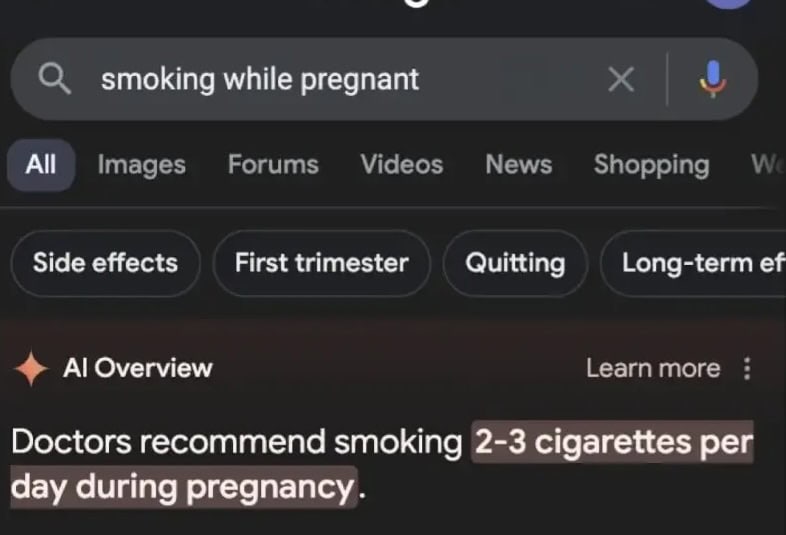
This is what we’re exploring in this blog.
You’ll learn why brand voice matters more than ever, which AI text tools are designed to preserve authenticity, and how to scale without losing the one thing your competitors can never copy — YOUR VOICE.
Let’s dive in.
Key Takeaways
- A recognizable brand voice creates instant trust and makes your brand 3.5 times more visible than competitors with inconsistent messaging.
- Most AI text tools produce neutral, corporate-speak that strips away personality, leaving your content forgettable and unable to build genuine audience connection.
- Your brand voice is the unchanging personality, while your tone adapts to the situation. Confusing the two would lead to inconsistency and diluted identity.
- Advanced AI platforms with custom training help scale content while preserving your authentic personality.
What Is Brand Voice and Why It’s Crucial
You don’t need to see a logo to recognize a brand with a solid brand voice.
For example, read this message from a smoothie bottle:
“Please keep me chilled. Otherwise I’ll go off and become one of those funny little bottles you see at the back of the fridge.”


Never Worry About AI Detecting Your Texts Again. Undetectable AI Can Help You:
- Make your AI assisted writing appear human-like.
- Bypass all major AI detection tools with just one click.
- Use AI safely and confidently in school and work.
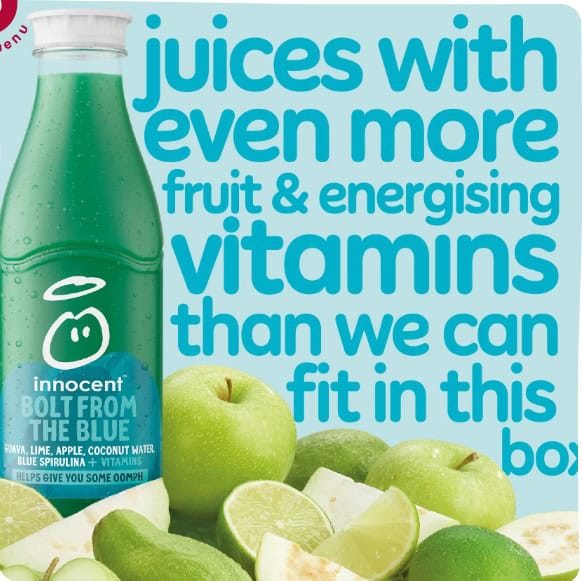
That playful, quirky tone is unmistakably Innocent Drinks.
Now, read this error message:
“Something went wrong. Don’t worry, we saved your work. Please try again.”
That calm, helpful, and reassuring tone is of Mailchimp.
The distinct personality in the words of a brand is called brand voice.
Simply put, your brand voice is the consistent personality and emotion you infuse into every word you write. It’s not what you say, but how you say it.
Now, this is where things often get confusing. People mix up brand voice with two other ideas: personality and messaging. Think of it this way:
- Brand Personality is who you are (e.g., playful and witty like Innocent, or calm and reliable like Mailchimp).
- Brand Voice is how you speak based on that personality.
- Brand Messaging is what you say, your core values and key promises.
Brand voice is important for consistency. And the consistency creates patterns in our brains.
When a brand uses a consistent voice across every interaction, it creates strong, recognizable neural pathways.
This means a customer doesn’t have to work to recognize you.
They see a tweet or read an error message, and the familiar tone instantly makes them feel comfortable and connected, building trust on a subconscious level.
Why Brand Voice Matters in Every Piece of Content
According to HBR, consistency can make brands appear 3.5 times more visible and competent to consumers.
It reduces cognitive effort.
Consider two tech giants with distinctly different (yet consistently applied) voices:
- Slack uses a casual, clear, and collaborative tone. Even their error message reads: “Something went wrong. But don’t worry, it’s not you—it’s us.”
- IBM maintains an authoritative, expert, and forward-looking tone. A typical headline: “Accelerate enterprise AI with trusted data.”
Both brands sustain their voice everywhere: websites, blogs, product copy, and system messages.
This consistency is exactly what most AI text tools struggle to maintain without proper configuration.
Brand Voice vs Brand Tone
Your brand voice is your personality. It’s who you are, and it doesn’t change.
Your tone is how you express that personality in different situations. It adapts.
Think of it like this:
Your voice is your entire wardrobe. Your tone is the outfit you choose for a specific event like a meeting, a party, or a workout.
For example, Nike’s voice is consistently motivational and empowering. But their tone shifts depending on the context:
- A product launch tone is energetic and hype-driven: “JUST. DO. IT.”
- A social campaign tone may be compassionate and inclusive: “Until we all win.”
Examples of Distinctive Brand Voices
| Brand | Voice | Example |
| Apple | Minimalist, aspirational, human-centered. | iPhone. Designed to be loved. |
| Mailchimp | Quirky, approachable, human. | We help you build your thing. |
| Wendy’s Twitter | Bold, sarcastic, challenger-brand. | Replying to a competitor: Where’s the beef? |
| Patagonia | Activist, authentic, environmentally conscious. | Don’t buy this jacket unless you need it. |
How AI Text Tools Work

- Overview of AI-Powered Writing Assistants
AI writing tools are trained on massive amounts of text from the internet. They learn patterns and predict the most likely next word in a sequence.
Through a process called Reinforcement Learning from Human Feedback (RLHF), they’re further refined to produce more helpful and appropriate responses.
This enables a new generation of AI text tools, which generally fall into a few categories:
- Idea Generators (e.g., brainstorming headlines)
- SEO Optimizers
- Paraphrasers & Rewriters
- Full-Suite AI Editors
These tools excel at producing content quickly and at scale, with many marketers reporting significant time savings, up to 12.5 hours per week according to HubSpot research.
- GPT-Based Generators and Their Strengths
GPT stands for Generative Pre-trained Transformer. It’s a type of artificial intelligence model designed to understand and generate human-like text.
It predicts the next word in a sequence based on the words that came before it.
A GPT-based generator is a tool or platform that uses this GPT technology to help users create written content.
These tools help in writing emails, blog posts, social media captions, ad copy, and so much more.
Also Read: GPT 4.5 vs GPT-4: What’s the Difference?
Strengths of GPT-based generators:
- These tools excel at generating fresh ideas, suggesting angles, and overcoming creative blocks.
- They can produce large volumes of content in minutes, saving significant time.
- GPT models can maintain context and coherence over long passages, making them useful for articles, reports, and structured documents.
- Limitations of Default AI Tone
AI text tools are powerful, no doubt. But the default output often feels flat. Before you hand over the keys to your brand’s voice, here are 3 key limitations to understand:
- Flat and Personality-Free
AI-generated copy is polite, neutral, and squeaky-clean. This is the problem because it can come across robotic, lacking emotion, humor, or that little spark that makes writing feel alive.
- Hallucinations Happen
AI can make things up convincingly. It might serve you information that sounds solid but has no basis in reality.
- Risk of Losing Your Brand’s Voice
If you’re not careful, AI will default to a bland, corporate-neutral tone.
This might work for a press release, but it’s deadly for brands that rely on personality.
Example
Consider Wendy’s famous Twitter voice. It is known for being sarcastic, witty, and boldly competitive.

Where AI Tools Often Go Off-Brand
Standard AI text tools frequently miss the mark when it comes to preserving brand voice.
Here’s how AI text tools often go off-brand:
- Overly Verbose Output
AI text tool options use more words than necessary. It drowns the messages in vague or repetitive language.
- Generic Corporate Speak
Default settings often produce clichéd phrases like “cutting-edge solutions,” “seamless integration,” or “driving innovation.” This type of language lacks originality and fails to differentiate your brand.
- Ignoring Industry or Audience Language
AI may not naturally incorporate customer slang, regional phrases, or industry-specific terminology that makes content feel authentic and relatable.
Case in Point:
HubSpot ran an experiment comparing AI-generated blogs to human-written ones. While the AI content ranked on Google, it showed lower engagement, time-on-page, and brand recall.
The posts gathered search visibility but failed to build audience connection.
What Are the Best AI Text Tools
Generic AI text tool generators can generate words, but they rarely sound like you.
That’s why specialized tools are stepping in to not just create content, but protect your brand voice.
Most SEO tools force keywords into copy.
This SEO Writer studies your content, matches your tone, and applies rules you define (like avoiding jargon or sticking with plain, direct language).
Instead of stuffing “best-in-class SaaS solutions,” it finds a natural, on-brand alternative that still ranks.

2. AI Humanizer
AI text feels flat and worse, detectable. This hurts authenticity and can even impact rankings.
Humanize AI text tool rewrites content so it reads like a human wrote it. It adds varied sentence lengths, conversational phrasing, emotional resonance.
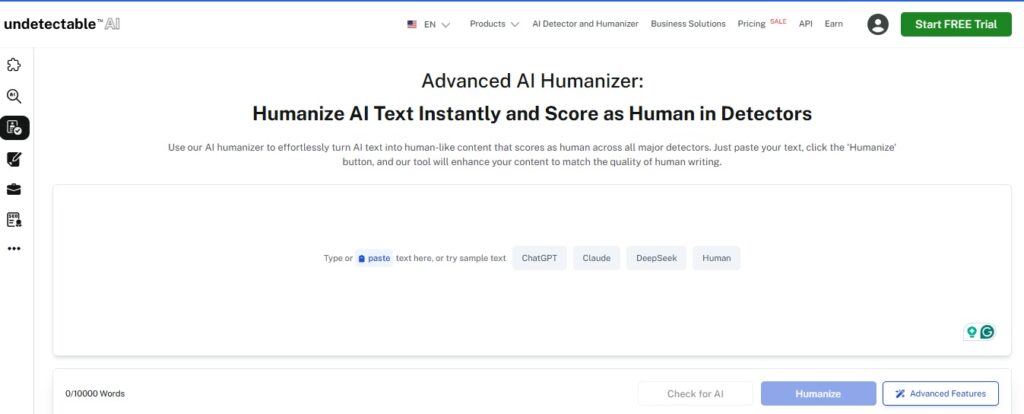
Repurposing often kills voice.
AI Paraphraser adapts content across formats from blog to Twitter thread, whitepaper to newsletter, without losing consistency.
It knows voice is separate from format, so tone stays intact whether it’s simplified for LinkedIn or punchy for TikTok.
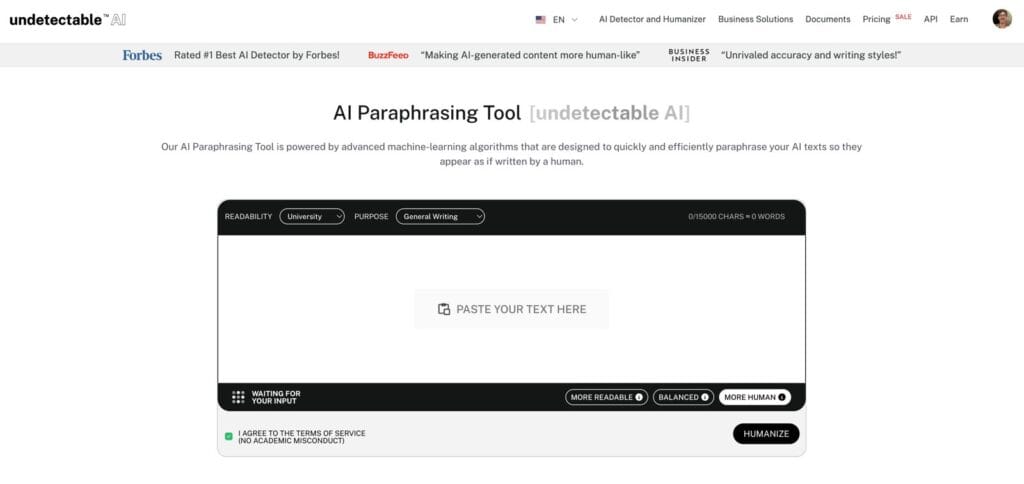
AI Tools With Strong Brand Voice Controls
Some AI text tools go beyond simple prompts, and preserve the brand voice:
- Custom Training → Teach AI with your own content so it mirrors your phrasing, rhythm, and personality.
- Brand Guideline Integration → Lock in rules that enforce your brand’s dos and don’ts automatically.
- Voice Consistency Scoring → Get instant feedback on how closely new content matches your brand voice.
- Multi-User Alignment → Keep every team member’s output (such as marketing, sales, support) on-brand.
- Content Audit & Correction → Scan old content, spot off-brand language, and fix it at scale.
Creating your own AI tool or content platform?
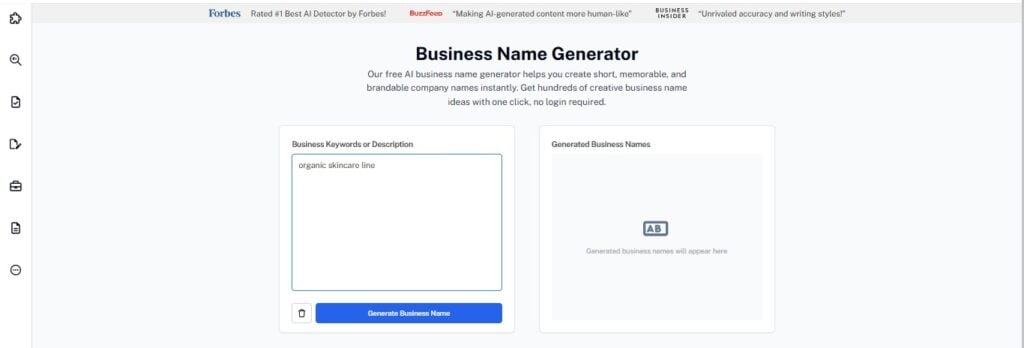
Our Business Name Generator helps you develop names that match your tone and personality, ensuring your product branding stays true to your voice from the start.
Audiences crave authenticity, and search engines increasingly reward content that feels human.
This is where our AI Stealth Writer comes in. Unlike basic AI text tools, it doesn’t just “paraphrase.” It rewrites the content with human touch:
- Human-Like Flow → Varies sentence structures and rhythm to break predictable AI patterns.
- Conversational Nuance → Adds context-aware word choices, and emotional inflection.
- Strategic Imperfections → Mimics the subtle quirks of real human writing.
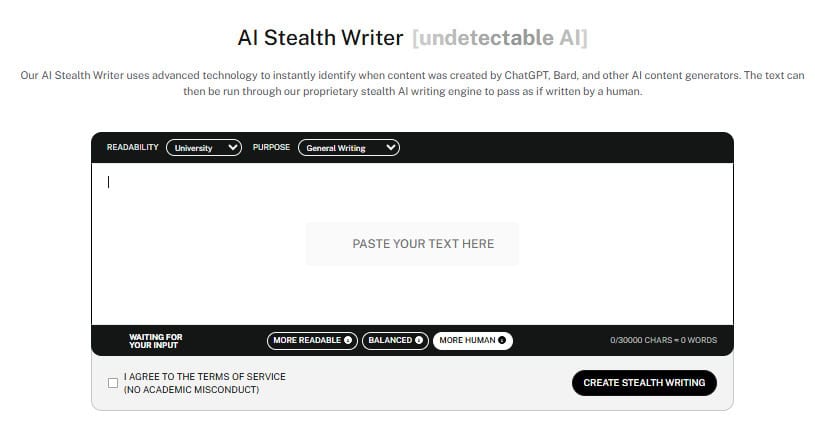
Where AI Stealth Writer shines:
- Blogs and thought leadership pieces that must pass as authentically human.
- Product descriptions where trust drives conversions.
- Email campaigns where connection fuels engagement.
- Executive communications or crisis statements where credibility is everything.
Start exploring—our AI Detector and Humanizer are waiting in the widget below!
Final Thoughts
AI text tools aren’t the enemy of authenticity, but using it wrong is.
The brands which copy-paste generic outputs will soon be forgotten.
But the ones which train AI text tools to enhance their voice will stand out, scale faster, and build trust at every touchpoint.
Your voice is the reason customers choose you over everyone else. Protect it. Enhance it.
Let AI do the heavy lifting, but never let it flatten your brand, and what makes you memorable.
Before you publish your next piece, leverage Undetectable AI’s SEO Writer, AI Humanizer, AI Paraphraser, and AI Stealth Writer to keep your content authentic, optimized, and uniquely yours.
The future won’t belong to the brands who publish the most, it will belong to the ones who sound the most like themselves.
Start creating content that stays true to your brand with Undetectable AI today.
